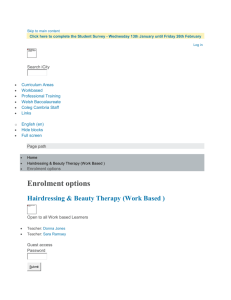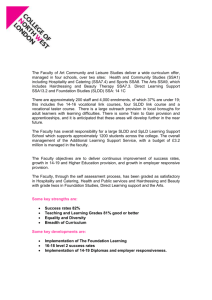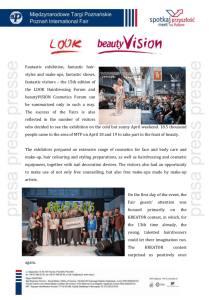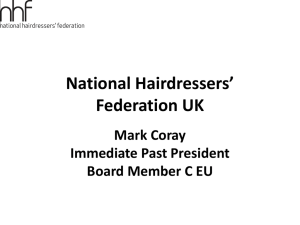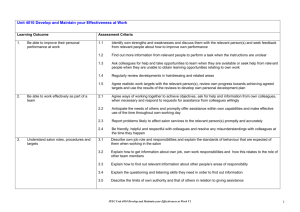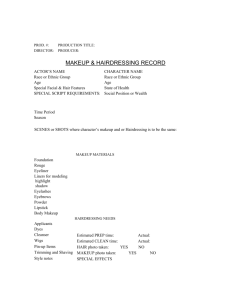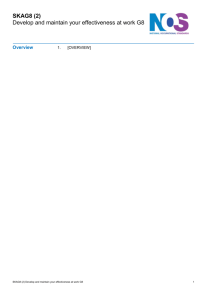hairdressing environmental scan 2014
advertisement
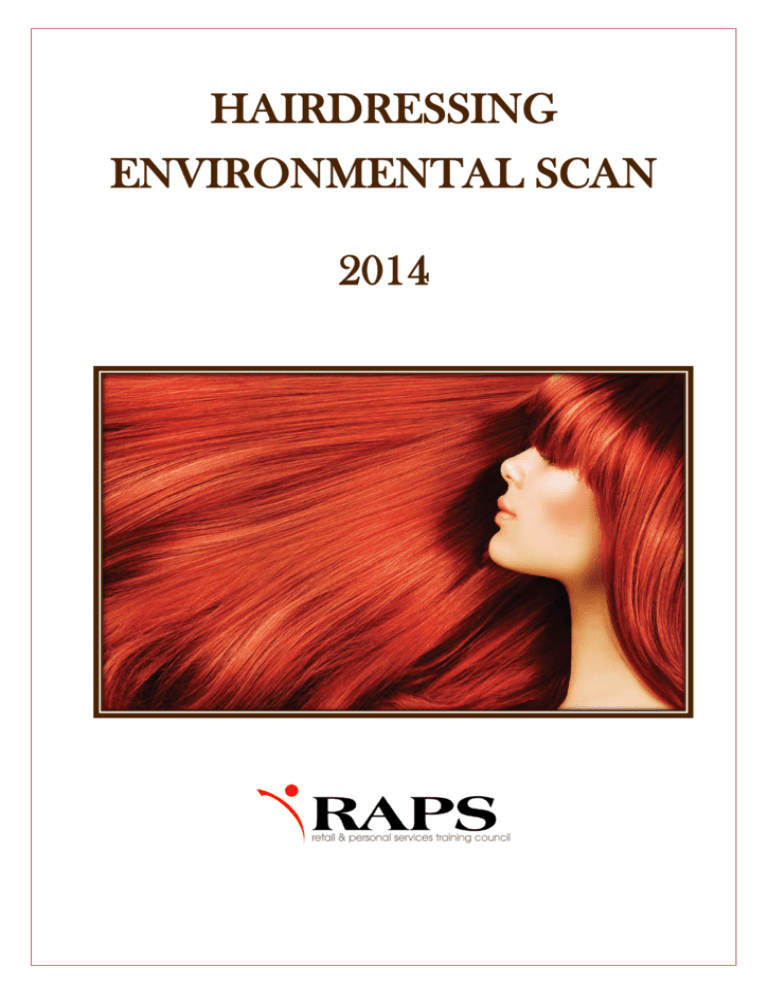
HAIRDRESSING
ENVIRONMENTAL SCAN
2014
1a.
OVERVIEW OF INDUSTRY
The Hairdressing Industry is captured in the Australian and New Zealand Standard Industrial
Classification (ANZSIC) under Group 951 ‘Personal Care Services’ in class 9511
‘Hairdressing and Beauty Services’ 1.
The Hairdressing Industry in Australia is predominantly made up of small and medium
enterprises, most employing between four and six people of whom a high share are
apprentices. While the majority of businesses are owner operated there are some chains,
including franchises. Most businesses are Australian owned with limited international
ownership. Competition is high and will remain high as a large number of salons compete for
clients.
Enterprises which employ less than 20 people account for an estimated 96.8% of businesses,
90% of industry employment and 86% of total revenue. 2 It is anticipated that the
hairdressing and beauty industry will generate revenue of $3.8 billion in 2013–14, growing
by 1.8%. 3
In November 2012, 66,100 people were employed in the Hairdressing Industry, of which
87.3% were female and 56.6% of hairdressers were full time employees. The main age group
is 25-34 years (26 per cent) and the median age is currently 32 years (compared to 40 years
for all occupations). 4
Hairdressing is currently the largest employing occupation in the personal services sector and
the largest employer of females in trades.
A large range of career opportunities are available within the hairdressing industry. Jobs are
available in hair salons cruise ships, magazines, photographic studios, fashion houses, theatre
and television companies and may also run their own business.
Hairdressing and Beauty Services have become closely aligned with the concept of health
and wellbeing. Companies spend millions of dollars researching skin treatments, anti-ageing
and rejuvenating products. The treatment of hair and skin has become a scientific study, with
ongoing new technological advancements in treatment processes being developed.
Job prospects for hairdressers are good, with employment to November 2017 expected to
remain relatively steady. 5
Trends Analysis
Hairdressing services account for 85% of the total revenue of salons. Manicures and beauty
treatments account for 5% and retail sales (such as shampoos and styling products) account
for the remaining 7%. It is estimated that about 65% of hairdressers provide basic beauty
services such as eyelash and eyebrow tinting, manicures and hair removal by waxing. A
lesser number provide application of make-up, facials, ear piercing and advice on cosmetics.
Less than 5% provide body massage, skin treatment with electrical equipment and pedicures. 6
It is also estimated that less than 5% of hairdressers hold beautician or beauty therapy
qualifications. However this is now changing with more specialists being employed.
The Industry derives most of its revenue from households. All people require hair-care
services at some point in time, whether this is done in a salon, at home or by an unregistered
'backyard' operator. It is estimated that women account for about 60% of total expenditure on
RAPS Hairdressing Environmental Scan 2014
2
hairdressing given their greater use of higher value added services and overall more frequent
use of these services over the year. 7 The gradual ageing of the population has led to an
increase in demand for hair colouring (with 6 weekly visits common in this area). Demand
for hair colouring services by males is on the rise. Industry suggests that part of the increased
demand for services is highly linked to cultural and demographic trends. In particular, the
ageing of the population, together with a cultural emphasis on appearance and youth, are
driving demand for beauty and hair services. Furthermore, the societal shift towards men
undertaking greater levels of grooming has contributed to an increase in demand for
hairdressing services and a rise in the number of barbers. 8
Regulatory Requirements
Hairdressing establishments are required by law to comply with the Hairdressing
Establishment Regulations 1972 which outline the basic health and Hygiene standards and
sterilisation procedures in order to prevent the spread of infectious diseases. Hairdressing
salons are also required to comply with the requirements of the Code of Practice for Skin
Penetration Procedures.
The Health Department of WA is in the process of updating the current regulations and
guidelines for body art and personal appearances. The regulations and guidelines will cover
Hairdressing, Beauty, teeth whitening, tattooing and body piercing.
Self-regulation
Under the recommendations of the ‘Reducing the Burden-Report of the red Tape Reduction
Group’ repeal of the Hairdressers Registration Act 1946, hairdressers are no longer required
to be registered to operate in Western Australia.
Hairdressing businesses are now directly responsible for ensuring they employ appropriately
trained and qualified staff by the sighting of qualifications.
Demographics of Workforce
•
•
•
•
Employment for Hairdressers to November 2017 is expected to remain relatively
steady. Employment in this very large occupation (66 100 in November 2012) rose
slightly steady in the past five years and rose moderately in the long-term (ten years).
Hairdressers have a low proportion of full-time jobs (56.6 per cent). For Hairdressers
working full-time, average weekly hours are 38.3 (compared to 41.3 for all
occupations) and earnings are low - in the first decile. Unemployment for Hairdressers
is average.
Hairdressers are employed across several industries including: Other Services; Health
Care and Social Assistance; Education and Training; and Wholesale Trade.
Over the five years to November 2017, the number of job openings for Hairdressers is
expected to be high (greater than 50, 000). Job openings can arise from employment
growth and people leaving this occupation. 9
RAPS Hairdressing Environmental Scan 2014
3
Key Indicators
The graph shows 9 key indicators for this occupation - employment size, full-time share of employment,
earnings, unemployment, historical employment growth (long-term, medium term and short-term), future
employment growth, mix of industries and job openings. Estimates have been rounded and consequently some
discrepancies may occur between sums of the component items and totals. 10
The main significant change in the data provided for 2011 key indicators and the above 2012
graph, is that the two year growth cycle has increased by 3 decile points.
Gender (per cent share)
The graph shows the share of employment (per cent) for males and females, employed full and part-time,
compared with all occupations. Source: ABS Labour Force Survey, annual average 2012. 11
RAPS Hairdressing Environmental Scan 2014
4
Employment Level (thousands)
The graph shows the historical and projected (to 2017) employment levels ('000) for this occupation. Source:
ABS Labour Force Survey, DEEWR trend data to November 2012 and DEEWR projections to 2017. 12
Population ageing is occurring globally, with a substantial shift in the age structure towards
older ages. The median age of Australia’s population (37.1 years at June 2011) is projected to
increase to between 38.7―40.7 years in 2026 and to between 41.9―45.2 years in 2056.
Australia’s population aged 15―64 years, which encompasses much of the working-age
population, is projected to decline from 67.4 % in 2007, to 60.5% in 2056. 13 As labour force
growth is forecast to be slower than population growth, participation rate decreases.
Age Profile (per cent share)
The graph shows the share of employment (per cent) by age group for this occupation, compared with all
occupations. Source: ABS Labour Force Survey, annual average 2021. 14
With the reduced youth pool, hairdressing businesses need to look at other groups as sources
of labour. Mature age workers in particular are increasingly valued for their life experiences
and preference for part-time work. 15
RAPS Hairdressing Environmental Scan 2014
5
Impact of Globalisation
The level of Globalisation is low but the trend of Globalisation is increasing.
The majority of businesses in this industry is Australian owned and earns most of their
revenue from domestic activity. There are no Australian-owned hairdressing salons that
operate internationally.
While there are some large global operators in the US, these companies have not as yet
moved into Australia. Toni & Guy Australia is owned by a UK-based global operator with
approximately 200 salons across five continents.
IBISWorld analysis suggests that this industry will be subject to increasing globalisation in
the future, as more international operators, probably from the US, enter Australia. 16
Impact of Government Policy/Decisions
Western Australia’s population is projected to reach 6.4 million people by 2061, creating
increasing demand for services. 17 Indeed, at 30 June 2013, the estimated resident population
(ERP) of Western Australia was 2.52 million, an increase of 81,000 (3.3%) over the previous
year. 18
The increasing cultural diversity of the workforce and of customers means that the ability to
work across cultures is becoming an essential skill for many employees, especially in service
related industries. Leadership and management skills are particularly important for handling
changes in Australian society and growth in cultural diversity of employees and customers.
Employers are likely to favor employees who can work and interact with people from
different cultural backgrounds. The importance of cultural self- awareness to students is on a
similar ranking to the importance of workplace relationships, communication skills,
compliance with policies and laws and customer service.
Deregulated trading hours
The Australian National Retailers Association (ANRA) has called for unrestricted retail
trading hours which would allow all shops to have the option of trading 24 hours a day, seven
days a week with the exception of Christmas Day, Good Friday and the morning of Anzac
day. 19
Coles and Woolworths support the call for national consistency of retail trading hours stating
that it would improve economic growth, reduce cost-of-living pressures on consumers and
help stores compete against online retailers. 20
The Australian Retailers Association (ARA) Executive Director Russell Zimmerman said
although the ARA supports the retail industry trading hours, caution must be taken to keep
smaller independent businesses alive. Mr Zimmerman stated that the call for uniform trading
hours may assist in economic growth in the short term, however smaller businesses will be
unsustainable with the pressures it will involve, and long term it may not prove to give
positive economic growth. If consumers want longer trading hours, then employment cost
and penalty rates must also be part of the discussion - without penalty rates being reviewed,
wages and on costs will be unstainable for the independent retailers in Australia. 21
The main union representing retail workers, the Shop Distributive and Allied Employees’
Association argues the main challenge facing industry is online sales by overseas retailers,
not labour costs and “sees no justification in any further extension of retail trading hours”. 22
RAPS Hairdressing Environmental Scan 2014
6
Western Australia
A study conducted in April by Patterson Research Group for independent grocers revealed
that almost nine out of ten (88per cent) of metropolitan shoppers believe that current
shopping hours are adequate for their needs.
The study showed satisfaction with the current system was not influenced by gender, with 88
per cent of men and the same number of women saying they were satisfied. Three quarters of
those in the 18 to 39 age group were satisfied with current hours.
The WA Independent Grocers Association president, John Cummings, said results were a
damning indictment of unsupported claims by major national retailers and big shopping
centre owners that consumers were demanding more shopping hours. 23
Penalty rates
Following a decision by the Fair Work Commission (FWC) on the Restaurant and Catering
award to reduce penalty rates by 25 percent on Sundays for casual employees, the Australian
Retailers Association (ARA) is hopeful they will see a common sense outcome in this year’s
Retail Award Review due later this year. The ARA believes there is sound economic and
social argument to bring penalty rates in line with Saturday rates. 24
Mr Ian Blandthorn of the Shop Distributive and Allied Employees’ Association totally rejects
the idea that wage and or labour costs are an impediment to effective competition in the
retail industry and argues that the modern retail award is flexible and has no limits on the
numbers of casuals that can be employed. 25
Technological
Technological advancements include the introduction of global keratin and other
nanotechnology treatments. These new services will need to be monitored and managed by
the industry, with the skills required to deliver them outlined in future training packages.
Salons are also increasingly incorporating software and information and communication
technology in their business processes. This includes the use of appointment management
software and text messages for appointment confirmation.
Salon workers are subsequently required to have sufficient digital literacy skills to engage
efficiently with these technologies. 26
The ability of salons to adapt to the constant changes of fashion and client requirements
continues to be the biggest challenge for this industry.
Economic drivers
The Hairdressing Industry has benefitted from a broader structural shift in the economy away
from goods and towards services. This is reflected in the forecast growth in employment in
this industry.
There has been an identified increase in the number of customers opting to purchase hair and
beauty products online. This trend is largely attributed to the consumer’s desire to save
money. Online stores, free from salon overheads, are able to offer lower priced products,
which impact upon in-store salon sales. This scenario is forcing salon owners and stockists to
review their commercial contracts, as their once ‘salon exclusive’ products can now be
purchased from other sources. There is also concern within the industry that the unmonitored
RAPS Hairdressing Environmental Scan 2014
7
nature of online sales is placing customers at risk as purchases can be made by people with
limited product knowledge. The sale of personal products through auction websites is a
further cause for concern as the seller has limited accountability for the product.
The ability of salon staff to provide unparalleled customer service is a strategy that salons
must consider in order to effectively maintain their sales of add-on products. This includes
comprehensive training in product knowledge as well as customer service skills and will
require salon owners and managers to develop a customer service culture. 27
Demand for Hairdressing Salon industry services is sensitive to changes in household
disposable income, fashion and social mores. Also important is the rate of population growth,
currently at a record 1.8% per annum (or an additional 407,000 people every year) through
both a high birth rate and immigration. 28 Ageing of the population also tends to increase
demand for higher-value services, such as hair colouring.
The industry tends to operate with a fair degree of price-based competition, resulting in a
high rate of salon closure. More professional operators concentrate on providing quality
service and results to clients, with high levels of customer satisfaction and repeat visits, rather
than attracting clients through price only.
It is forecast that through to 2016-17, industry revenue will grow to $4.24 billion, which will
be supported by economic expansion from 2011-12 and strong population growth. Demand
for higher priced, value added services and products will grow, as will employment however poor consumer confidence will be a factor to consider. 29
Competition in this industry is high and is increasing. The main basis of competition between
hairdressers is price, and profit margins are therefore very low. The industry is mostly
comprised of small businesses, due to low entry barriers, and there is a general perception
among operators that customers choose their hairdresser on the basis of price only, although
this is not always the case.
External competition comes from 'backyard' hairdressers who perform their services at home
(as opposed to a salon), as well as from the DIY sector, as some people do their own hair
treatments using off-the-shelf products.
Overall revenue volatility in hairdressing segments is low, due to the sheer volume of people
who use these services on a regular basis. However, the demand for hairdressing services
and beauty is related to changes in household income, which particularly affects the demand
for higher priced; value added services and retail product sales. Changes in frequency and use
of higher priced, value added services are also linked to changes in consumer sentiment,
which fluctuates with economic activity.
Fashions in hairstyles affect the demand for hairdressing services, especially frequency of
use. A current higher population growth rate is influencing the demand for hair-care
services. 30
Size and Distribution
The level of industry concentration is slowly increasing in this highly fragmented industry
with most enterprises being small, owner-operated businesses. Some chains exist (usually no
more than two or three shops) and a number of franchises have emerged, a trend which is
expected to continue.
RAPS Hairdressing Environmental Scan 2014
8
Enterprises which employ less than 20 people account for an estimated 99% of businesses,
90% of industry employment and 86% of total revenue.
Business Locations by State (2011-12)
Region
NSW
VIC
QLD
WA
SA
TAS
ACT
NT
Percentage
33
25
20
9
8
2
2
1
Hairdressing and beauty salons are generally located in direct proportion to population size
and spread. There tends to be a higher concentration in central business districts.
Queensland and Western Australia have a larger share of locations than their population
share, due to their geographic size, and having a more dispersed population. 31
RAPS Hairdressing Environmental Scan 2014
9
Employment by region (per cent share)
The graph shows the State share of employment (per cent) for this occupation, compared with all occupations.
Source: ABS Labour Force Survey, annual average 2012. Estimates have been rounded and consequently some
discrepancies may occur between sums of the component items and totals. 32
Regional Aspects
Although there are no identified shortages of hairdressers in Western Australia, there was a
critical shortage of hairdressers both in the metropolitan and regional areas during the last
surge in the mining sector. The lack of availability of skilled labour and a lack of
accommodation to house workers in the areas of need were the reasons identified for this
shortage. More recently, Karratha and Port Hedland’s accommodation shortage has been
eased through Royalties for Regions, which has assisted in relieving the shortage for service
industry workers.
There is a lack of career opportunities for females in regional areas – this was particularly
noticeable in the Goldfields and Esperance regions during RAPS regional visits to these
areas.
There is also a need to develop training programs for Indigenous youth, particularly females
in the Broome and Fitzroy Crossing regions.
The introduction of extended trading in the Perth metropolitan area does not affect trading
hours’ arrangements in regional areas. Regional traders may choose when they open within
the trading hours specified for their locality.
Sustainability
One of the vital workforce development needs for the services industries is the requirement
for training packages to incorporate and adopt the principles of sustainability. Although the
service industries are not seen as a major contributor to high carbon levels and a polluted
environment, it is one of the industries with the most customer contact and therefore presents
possibilities to build awareness to the community.
There is an increasing awareness amongst both men and women of the need to maintain
personal grooming and the use of natural, herbal, organic, hypo-allergenic and nutraceutical
RAPS Hairdressing Environmental Scan 2014
10
products. People continue to search for natural products containing botanical extracts, plant
acids, enzymes, herbs, vitamins and proteins. Growing awareness of health and wellbeing in
the population will see increased demand for more health-oriented products. 33
The Hairdressing Industry are improving their work practices by the use of water and energy
saving options, the safe disposal of chemicals, addressing waste management practices, and
alternative less harmful products such as low ammonia hair colours. These changes are due in
part to consumer demand for “green’ products and services, and companies becoming more
aware of the need to develop more efficient and sustainable work practices. 34
Qualification Profile of Workforce
Hairdressing is labour and skill intensive. By their nature hairdressers require a high level of
one-on-one contact with the client and personalized services is paramount for customer
satisfaction and ultimately the success of the business. The labour to capital intensity measure
outlines the amount of labour as opposed to capital costs. In essence for every dollar in wages
costs an average of 11 cents is spent on the use and replacement of buildings and equipment.
Hairdressing Training Package Qualifications now being delivered in Western Australia are:
•
•
•
•
•
•
Certificate II in Hairdressing - Pre-Apprenticeship in Hairdressing
Certificate II in Hairdressing
Certificate III in Hairdressing
Certificate IV in Hairdressing
Diploma of Hairdressing
Vocational Graduate Certificate in Hairdressing Creative Leadership
Continuous Improvement
The planned continuous improvement of the SIH11 Hairdressing Training Package will
ensure that the needs of industry and the National Skills Standards Council’s (NSSC)
Standards for Training Packages are met. It is anticipated that the SIH Hairdressing Training
Package will be submitted for endorsement in mid - 2015.
RAPS Hairdressing Environmental Scan 2014
11
Educational Attainment (per cent of employment)
The graph shows the highest educational attainment (per cent share of employment) for this occupation
compared with all occupations. Source: ABS Census of Population and Housing, August 2011 (DEEWR custom
request data). The measure of overall educational attainment is the ABS ‘HEAP’ variable, which regards
successful completion of Years 12, 11 or 10 of school as a higher attainment than a Certificate II coupled with
any lower level of schooling. Estimates have been rounded and consequently some discrepancies may occur
between sums of the component items and totals. 35
Social Impact
Australia’s estimated resident population at 30 June 2013 was 23.1 million, constituting a
growth of 1.8%. Western Australia had the fastest annual rate of growth (3.3%) where the
population was estimated to be 2.52 million at June 2013. 36 This population growth will lead
to an increased demand for workers in the service industries. Furthermore, this requires
productivity gains in order to service the growing number of customers. In addition to this
natural growth, population growth attributable to overseas migration has had the effect of
contributing to an increasingly culturally diverse community. For service-related industries, it
is particularly important that staff have thorough knowledge of cross-cultural differences. The
largest increase in overseas arrivals in 2011 was also in Western Australia. 37
In addition, the rise in the average Australian living standards will also generate an increased
demand in the service sector as consumers' tastes and expectations are increasingly
sophisticated. Customers are increasingly well-informed and have rapidly rising expectations
of value.
The wide range of products and services makes the personal advice provided by professionals
even more important, hence reinforcing the need for ongoing training. In addition, companies
also need to offer specialised services to add more value to their products and differentiate
themselves from their competitors. This leads to growing convergence between the
hairdressing and beauty sectors. For instance, many hair-salons have added beauty to their
services in order to broaden what they offer customers, to attract more clients and stay
competitive.
For any service business, skill retention and utilisation is a major factor to continuously
provide good customer service, differentiate itself from competitors and grow. Workforce
development strategies need to vocationally develop people who want to stay in an industry
and develop themselves. The ongoing training of employees must be a priority for managers,
to strengthen their employee recruitment strategies and staff retention plans. Current and
RAPS Hairdressing Environmental Scan 2014
12
industry driven technical training are essential to respond to an increasing population
and the constant change of fashion and techniques.
As the majority of service industry businesses are on a small scale, the owner or manager
has to fulfill several tasks and jobs which requires well developed skills in resource
management and planning. Unfortunately, there is a tendency not to undertake training until a
business is in difficulty. Instead, management training should commence earlier and be
ongoing to give their business the best opportunity to survive current and future challenges.
Population ageing is occurring globally, with a substantial shift in the age structure towards
older ages. The median age of Australia's population (37.1 years at June 2011) is projected to
increase to between 38.7-40.7 years in 2026 and to between 41.9-45.2 years in 2056.
Australia's population aged 15-64 years, which encompasses much of the working-age
population, is projected to decline from 67.4% in 2007, to 60.5% in 2056. As labour force
growth is forecast to be slower than population growth, participation rate decreases. 38
1b.
INDUSTRY OCCUPATIONAL OVERVIEW
Supply and Demand of Training
Currently, hairdressers are in a shortage in the areas of Karratha, Broome and Kununurra
which is caused not so much by a skill shortage but a shortage of affordable and available
housing. During the last surge in the mining sector there was a critical shortage of
hairdressers both in the metropolitan and regional areas. This was in part due to a lack of
availability of skilled labour and a lack of affordable and available accommodation to house
workers in the areas of need. More recently, Karratha and Port Hedland’s accommodation
shortage has been eased through Royalties for Regions, which has assisted in relieving the
shortage for service industry workers. However, whilst there is not a shortage of qualified
hairdressers, there is a shortage of “skilled” hairdressers which industry has identified as
largely due to the apprenticeship being changed from a four year term to a three year term. A
recent survey conducted by the RAPS Training Council identified overwhelming that the
industry required a return to the four year term of apprenticeship.
Due to the specialised work and the time involved to train a hairdresser, apprentice numbers
will need to remain steady so that a shortage does not occur again.
The change in immigration policies will also ensure that there is not an oversupply of
international students in this industry.
Many businesses within the service industries have had to face shortages of labour in the last
few years. The poor perception by sections of the public to industries like the hairdressing
industry as viable career choices hinders entry into these sectors by young people. Feedback
has indicated that information sessions regarding training in this industry need to be
improved and those delivering the information need to have greater skills in communicating
the potential job outcomes.
Employers in the industry have mixed experiences regarding the quality of vocational
training, assessment and the level of experience and competence of trainers and assessors. In
order to be effective in reducing labour shortages and to produce an adaptable workforce,
training has to be appropriate and meet accepted industry requirements and standards. New
RAPS Hairdressing Environmental Scan 2014
13
employees at Certificate III entry level have to be skilled enough for full employment
responsibilities through qualitative (using up-to-date technology) and quantitative (having
enough time to practice new skills) training.
A pilot pre-apprenticeship program developed by RAPS for the hairdressing industry
commenced in February 2014, across Western Australia in various private and state
providers, and is planned to run for a year.
Current and Emerging Skill/Labour Gaps
If a blanket approach to workforce development is adopted, the result will be an under
representation of the development of service industries workers.
The reality of a blanket approach to workforce development is that jobs that will be available
in the hairdressing industry will be at Certificate III in Hairdressing level. This skill level is
suited to the majority of employer needs. It should be noted though that while the mismatch
in supply and demand does represent a need for higher level skills for those who do not
possess a qualification, it does not reflect a demand for training at management or diploma
level. 39
An emerging skills gap for the hairdressing industry has been identified as business
management training particularly in small to medium enterprises.
Retention of talent is an important factor in the hairdressing industry and indications are that
critical to the retention process is the harnessing the potential to fully engage employees in
the industry. Skills and workforce development strategies are among the most influential
retention tools to workers.
A significant feature of the hairdressing industry is the large number of small and medium
sized enterprises (SMEs). There is a range of qualities that successful businesses must have to
effectively build and sustain their operations. SSA believes that a key role of government
should be to provide advice and support to SMEs to support the development of skills and
systems to improve productivity.
Leaders and managers of SMEs fulfill a wide range of roles requiring a variety of skills. The
global financial crisis (GFC) has highlighted the need for managers to have a greater
knowledge and understanding of financial matters, technology, business planning and human
resource management. Industry feedback to SSA strongly supported the need for managers to
have a better understanding of the global economy and how it relates to their businesses and
to have financial management skills to understand business processes that maintain
profitability.
Human resource management skills are critical to managing workforces with diverse needs
and improving their productivity and morale, which in turn can improve individual and social
wellbeing and so contribute to socioeconomic mobility and economic growth.
To be effective, training for managers in broad areas of finance and human resource in the
hairdressing industry requires a long-term approach. Convincing employers that training at
Certificate IV and Diploma levels is necessary for relevant existing workers may be a way of
starting the process. While this may be relatively easy for large businesses, it will be more
difficult for smaller businesses where the employer is also the manager.
RAPS Hairdressing Environmental Scan 2014
14
Many people who buy into small business are motivated by a belief in their business
experience and are not aware of the limitations of that experience. The consequences of poor
management are dire for others in the supply chain, who are left with large debts when
businesses fail. 40
There is a strong industry pathway of hairdressers opening their own salon, yet some do not
have the requisite business skills to operate profitably. Industry reports that it is not standard
practice to upgrade their management skills when moving into management positions.
Therefore skills in finance, human resources and promoting the learning and development of
staff can be lacking. 41
There is a clear demand from the hairdressing industry to train and skill senior hairdressers in
order to not only address the skill gaps but additionally as a retention strategy.
The Pilot Pre-apprenticeship program was developed by RAPS, with a view to sustaining the
training for the long term and to introduce young people into hairdressing as a career
pathway.
Emerging occupations
There are no identified emerging occupations.
Declining occupations
There are no identified declining occupations.
RAPS Hairdressing Environmental Scan 2014
15
ENDNOTES
1
Australian Bureau of Statistics. (2014). Australian and New Zealand Standard Industrial Classification
(ANZSIC). February 2014 (Cat. No. 1292.0).
2
IBISWorld. (2011). Hairdressing and Beauty Salons in Australia: Q9526. Market Research Report.
3
IBISWorld Snapshot February 2014 – Hairdressing and Beauty Services in Australia: Market Research
Report.
4
Australian Government. (2012). Job Outlook – Hairdressers http://joboutlook.gov.au/jouploads/3911.pdf
5
Australian Government. (2012). Job Outlook – Hairdressers
http://joboutlook.gov.au/occupation.aspx?search=alpha&tab=prospects&cluster=&code=3911
6
IBISWorld. (2012). Hairdressing and Beauty Salons in Australia: Q9526. Market Research Report.
7
8
IBISWorld. (2012). Hairdressing and Beauty Salons in Australia: Q9526. Market Research Report.
Service Skills Australia. (2014). Wholesale, Retail & Personal Services Environmental Scan.
9
Australian Government. (2012). Job Outlook – Hairdressers
http://joboutlook.gov.au/occupation.aspx?search=alpha&tab=prospects&cluster=&code=3911
10
Australian Government. (2012). Job Outlook – Hairdressers
http://joboutlook.gov.au/occupation.aspx?search=alpha&tab=prospects&cluster=&code=3911
11
Australian Government. (2012). JOB OUTLOOK – Hairdressers
http://joboutlook.gov.au/occupation.aspx?search=alpha&tab=stats&cluster=&code=3911&graph=SHOWALL
12
Australian Government. (2012). Job Outlook – Hairdressers
http://joboutlook.gov.au/occupation.aspx?search=alpha&tab=stats&cluster=&code=3911&graph=SHOWALL
13
Australian Bureau of Statistics. (2012). Year Book Australia, May 2012. (Cat. No. 1301.0).
14
Australian Government. (2012). Job Outlook – Hairdressers
http://joboutlook.gov.au/occupation.aspx?search=alpha&tab=stats&cluster=&code=3911&graph=SHOWALL
15
Service Skills Australia. (2012). Hairdressing and Beauty Environmental Scan.
16
IBISWorld. (2012). Hairdressing and Beauty Salons in Australia: Q9526. Market Research Report.
17
Australian Bureau of Statistics. (2013). Population projections, Australia, 2006 to 2101. (Cat. No. 3222.0).
18
Australian Bureau of Statistics. (2013). Australian Demographic Statistics, June 2013. (Cat. No. 1301.0).
19
Australian National Retailers Association. (May 2014). Media Statement: Trading hours – pursuing fairer
trading.
20
Balogh, S. (2014, May 26). Woolworths and Coles unite on trading). The Australian. Retrieved from
http://www.theaustralian.com.au/national-affairs/policy/woolworths-and-coles-unite-on-trading/story-fn59noo31226931112552#
21
The Australian Retailers Association. (May 2014). Media Statement: The big two call for uniform trading
hours – small businesses call for support.
22
Balogh, S. (2014, May 26). Woolworths and Coles unite on trading). The Australian. Retrieved from
http://www.theaustralian.com.au/national-affairs/policy/woolworths-and-coles-unite-on-trading/story-fn59noo31226931112552#
23
Inside Retail. (2014, May 22). WA shoppers satisfied. Retrieved from
http://www.insideretail.com.au/2014/05/22/wa-shoppers-satisfied/
24
Retailworld eNewsletter. (2014). Retailers hopeful following hospitality penalty rates decision.
25
Balogh, S. (2014, May 26). Woolworths and Coles unite on trading). The Australian. Retrieved from
http://www.theaustralian.com.au/national-affairs/policy/woolworths-and-coles-unite-on-trading/story-fn59noo31226931112552#
RAPS Hairdressing Environmental Scan 2014
16
26
Service Skills Australia. (2014). Wholesale, Retail & Personal Services Environmental Scan.
27
Service Skills Australia. (2012). Hairdressing and Beauty Environmental Scan.
28
Australian Bureau of Statistics. (2013). Australian Demographic Statistics, June 2013. (Cat. No. 1301.0).
29
IBISWorld. (2012). Hairdressing and Beauty Salons in Australia: Q9526. Market Research Report.
30
IBISWorld. (2012). Hairdressing and Beauty Salons in Australia: Q9526. Market Research Report.
31
IBISWorld. (2009). Hairdressing and Beauty Salons in Australia: Q9526. Market Research Report.
32
Australian Government. (2012). Job Outlook – Hairdressers
http://joboutlook.gov.au/occupation.aspx?search=alpha&tab=stats&cluster=&code=3911&graph=SHOWALL
33
IBISWorld. (2012). Hairdressing and Beauty Salons in Australia: Q9526. Market Research Report.
34
Service Skills Australia. (2014). Wholesale, Retail & Personal Services Environmental Scan.
35
Australian Government. (2012). Job Outlook – Hairdressers
http://joboutlook.gov.au/occupation.aspx?search=alpha&tab=stats&cluster=&code=3911&graph=SHOWALL
36
Australian Bureau of Statistics. (2013). Australian Demographic Statistics, June 2013. (Cat. No. 1301.0).
37
Service Skills Australia. (2012). Hairdressing and Beauty Environmental Scan.
38
Australian Bureau of Statistics. (2012). Year Book Australia, May 2012. (Cat. No. 1301.0).
39
Service Skills Australia. (2010). Hairdressing and Beauty Services Environmental Scan.
40
Service Skills Australia. (2010). Hairdressing and Beauty Services Environmental Scan.
41
Service Skills Australia. (2014). Wholesale, Retail & Personal Services Environmental Scan.
RAPS Hairdressing Environmental Scan 2014
17
